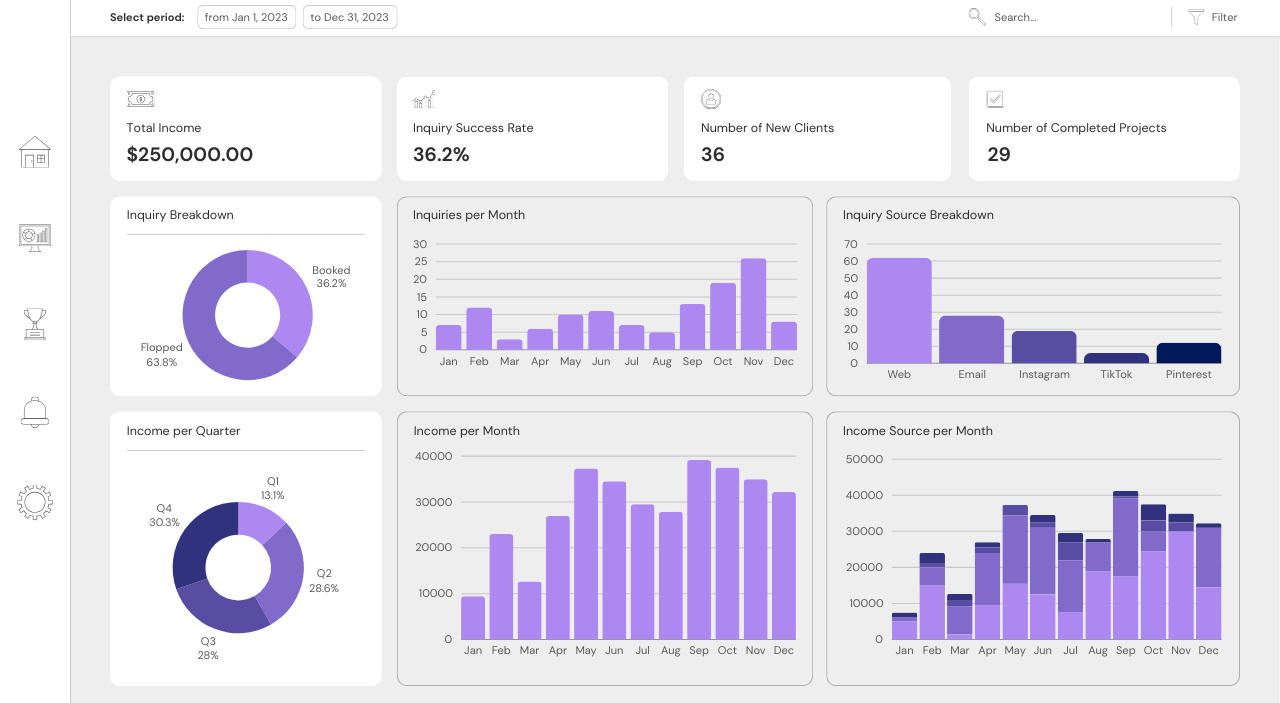Customer service now involves more than just answering calls and emails. It’s about understanding each interaction and predicting what customers will need.
Let’s say you work as a customer support manager and that each client interaction is an opportunity to strengthen your customer service.
Using customer service analytics helps you understand your customers better and build stronger connections with them.
This blog explores customer service analytics, focusing on getting to know the customer’s voice and any details to help provide great service.
What is customer service analytics?
Customer service analytics refers to the regular collection and analysis of customer data to get valuable insights about the overall customer service to enhance customer support.
This process involves gathering data on customer interactions but also information on:
- Agents’ performance
- Ticket resolution
- Ticket response time
- Customer service analytics tools
- Customer experience satisfaction
Businesses can collect customer data from different sources such as message conversation history, transactions, and survey responses.
Customer service analytics can help you understand support patterns, know your customers’ wants and preferences, and set business goals.
Types of analytics in customer service
Customer service analytics can be divided into different categories, such as:

Customer journey analytics
Involves mapping out the various customer touchpoints and interactions that customers have with a company across different channels and stages of the customer lifecycle.
This enables businesses to identify pain points, enhance connection, and improve the overall customer experience.
Customer engagement analytics
Involves analyzing interactions and behaviors through different channels such as social media, email, community forums, or insights obtained from surveys.
This helps businesses to understand how customers interact with a brand and create engagement strategies and content to build stronger relationships.
By measuring the key metrics businesses can evaluate the effectiveness of their engagement efforts and refine their strategies to better resonate with their target audience.
Customer experience analytics
Involves analyzing customer feedback, behavior, and interactions across multiple connections to understand their satisfaction levels, preferences, and pain points.
This enables businesses to improve processes and deliver personalized experiences, thereby enhancing overall customer satisfaction and loyalty.
Using insights from customer experience metrics, businesses can identify areas for improvement, tailor their products or services to meet customer needs, and ultimately drive growth through enhanced customer retention and advocacy.
Customer retention analytics
Is a process that helps businesses understand why customers stop using their services or products.
This process involves analyzing customer feedback, behavior, and interactions to identify the factors that influence customer churn.
By using insights from customer retention analytics, businesses can proactively address customer concerns, improve customer experience, and build stronger connections with their customer base.
Additionally, businesses can take corrective actions to keep important customers happy and retain them for longer periods.
Customer support analytics use cases
How do you analyze customer service data? The following are a few instances of regular uses for customer service analytics:
Monitor and analyze the customer journey
Identify and track the customer journey map throughout their interaction with your business across various touchpoints.
This will help you understand their challenges, identify customer pain points, and improve service delivery for improved satisfaction and loyalty.

Businesses can gain valuable insights into customer behavior through customer service analytics.
This enables them to improve customer interaction, optimize resource utilization, and maximize agent effectiveness, ultimately leading to cost savings.
Evaluate support staff work progress
Using customer service analytics helps businesses keep an eye on how well support agents perform on their tasks.
By analyzing the support teamwork progress, managers can identify patterns, use resources well, and set up specific training to make customer support better.
Improve in different areas of businesses
Businesses can analyze customer feedback by using customer service analytics to help them identify recurring support issues, and areas to improve, and know what their customers like or dislike.
With such insight, these businesses can make the necessary improvements to suit customers’ needs better and prioritize development efforts to address the key concerns. This will enhance the overall customer service experience.
Boost customer loyalty and retention
Customer service analytics help your support teams find unhappy customers who might want to leave or lose trust and apply effective strategies for customer retention to prevent this.
Businesses can proactively address customer needs, enhance satisfaction levels, and cultivate long-term relationships, by using insights gained from customer analytics service ultimately fostering loyalty and reducing customer churn.
Enhance ticket prioritization
Sentiment analysis and difficult issues should be the basis for ticket prioritization and tagging.
Customer service analytics can assist businesses in identifying these factors, reducing the likelihood of SLA breaches and ticket escalations.
Making better decisions based on the insights
Businesses discover customers’ behaviors and preferences more deeply through consumer data analysis.
The information from this data can assist businesses in making better decisions about product development, marketing campaigns, and service activities.
Reduce customer service costs and increase revenue
With customer service analytics, businesses can identify important customers and collect more information on their opinions, suggestions, and purchasing patterns.
The information helps businesses improve their products and marketing strategies to reach important customers, leading to more sales and profits.
AI in customer service analytics
According to a Redixweb study, 83% of businesses worldwide claim that AI is crucial to their operational processes.
AI in customer service analytics uses smart techniques to study customer data that can be used to make support better and keep customers happy.
- Sentiment analysis tools help businesses understand customers’ feelings and emotions, allowing them to address concerns better and improve their brand perception.
- Predictive analytics methods predict customer behavior, to enable proactive services and create interactions.
- Businesses can use AI analytics platforms to track customer service KPIs like response times, resolution rates, and customer satisfaction scores.
Companies use this data to improve processes and enhance the customer experience.
As a result of using AI in customer service analytics, businesses can streamline customer service processes with AI technologies by;
- Building long-term customer relationships
- Enhancing overall customer service performance
Monitoring customer service analytics helps businesses understand the value of customer support efforts and improve in those areas.
Metrics you can use for client data analysis
The following are the metrics businesses can use to analyze customer service performance:
1. Customer service metrics for maintaining customer experience
These metrics are essential for businesses to measure and improve the quality of interactions between customers and the company.
The KPIs for gauging customer service experience include:
Customer satisfaction score (CSAT)
The customer satisfaction score (CSAT) measures and checks how satisfied customers are you’re your service quality.
It helps businesses build loyalty, keep customers, create their brand image, and reduce support costs.
A Harvard study found that 80% of customer service businesses use customer satisfaction scores(CSAT) as their primary metric for measuring customer experience when they aim to exceed expectations.
Customer effort score (CES)
The customer effort score calculates how easy it is to use your products or services. Engage your clients by asking them, ‘How effortless was it for you to receive the assistance you desired today?
It helps businesses gauge how easy or difficult it is for customers to interact with your company at different touchpoints.
Lower scores indicate a smoother and more satisfactory experience for customers.
Net promoter score (NPS)
The net promoter score (NPS) is a metric used to measure customer loyalty and satisfaction based on their likelihood to recommend a company’s products or services to others.
This helps businesses to know how loyal and satisfied customers are by sorting them into promoters, passives, or detractors.
2. Customer service metrics for measuring customer journey
This involves tracking and analyzing customer interactions and experiences across various channels throughout their journey with a company.
Customer service metrics play a crucial role in understanding and improving the customer journey.
Here are some of the KPIs for measuring customer journey analytics:
Customer lifetime value (CLV)
The customer lifetime value calculates the amount that every client adds to the company throughout their relationship.
The data helps the company make strategic decisions about getting and keeping customers.
It can also help customer service teams find important clients who need more help.
Businesses can use data analysis to find what customers like and dislike, which helps them modify their customer service strategies and products to meet customer expectations and maintain happy customers.
Customer retention rate (CRR)
The customer retention rate (CRR) refers to the percentage of clients a company maintains over a specific period.
It shows how effective it is at retaining customers and how well customer service works.
A high CRR indicates successful customer retention, satisfaction, and loyalty, allowing organizations to identify areas for improvement.

3. Customer service metrics for measuring customer performance
Customer service metrics for performance are the main measures that businesses use to assess the productivity and efficiency of their customer service operations.
With these metrics, businesses can analyze their progress over time, identify areas for development, and assess how effectively they are satisfying client demands and expectations.
Here are the KPIs used to measure performance:
First response time
This shows how quickly and efficiently a company replies to a customer’s first question or problem.
A quick and effective initial response indicates a responsive and customer-centric support system.
This metric is critical in building customer trust and satisfaction, influencing overall perceptions of a company’s service quality.
First contact resolution (FCR)
First contact resolution measures the percentage of customer inquiries or issues that are resolved during the initial contact with customer service, without requiring additional follow-up.
For example, if a customer calls with a product inquiry and the support agent successfully resolves the issue without needing the customer to call back, it counts as a first contact resolution.
Average resolution time (ART)
This metric measures the average time it takes for customer issues to be resolved.
Businesses use it to provide insight into the efficiency of the support teams in addressing and resolving customer problems.
For instance, if a customer calls with a billing issue, the Average resolution time would track the time it takes from the initial contact to resolution.
Contact ticket volume
Contact volume measures the total number of customer inquiries or issues received by the customer service team within a specific timeframe.
It helps businesses to understand the total workload of tickets and the demand on the customer service department to make important decisions.
4. Customer service metrics for measuring customer engagement
Customer engagement analytics measures and examines customer interactions with a business through multiple channels such as social media, website, email, and community forums.
It contains monitoring customer engagement metrics to value the productivity of customer engagement programs.
The KPIs for measuring customer engagement include.
Social media analytics
Businesses use various channels for customers to express their opinions and experiences. These platforms help companies to understand the overall sentiment of their brand.
To gauge the effectiveness of social media marketing campaigns and identify trends in customer behavior, businesses analyze engagement metrics such as likes, shares, comments, and click-through rates on social media platforms.
Website analytics
Tracking metrics such as page views, time spent on the site, and conversion rates to understand how users interact with your website and optimize its performance.

Customer support analytics
Tracking metrics like response time, resolution rates, and customer feedback in customer support interactions to identify common issues, improve service quality, and enhance customer satisfaction.
5. Customer service metrics for measuring customer retention
This involves analyzing data and metrics related to customer behavior, interactions, and engagement to understand why customers stay with the company or why they leave the company.
It aims to help businesses identify patterns and trends that require perfection and influence customer retention rates.
The KPIs for measuring customer retention analytics contain:
Customer churn rate (CCR)
Customer churn rate (CCR), measures the percentage of customers who stop doing business with a company within a certain period.
A high CCR suggests potential issues with customer satisfaction, service quality, or overall customer experience.
Monitoring CCR allows businesses to identify pain points, address customer concerns, and improve service offerings to reduce customer attrition.
Customer acquisition cost
Customer acquisition cost is a metric that is used to measure the total cost incurred by a business to acquire a new customer, including expenses related to marketing, sales, and promotional activities.
It helps businesses allocate marketing budgets effectively, optimize customer service ROI, and identify efficient marketing channels by measuring the cost incurred to acquire each new customer.
Gain valuable insights with customer service analytics
With client data analysis, businesses can gain important insights into the support they provide.
They can look at data like customer interactions, ticket resolutions, how well agents perform, feedback from customers, and more.
Deep research allows businesses to discover trends, patterns, and opportunities to improve their customer service operations.
Additionally, customer insights can help you to understand what they prefer or need. You can also make their support experiences personal to efficiently meet changing demands.
Managers must adopt customer service strategies that value customer intelligence and encourage support teams to use all helpful information to improve quality and make customers happier.
Book a live demo to see how BoldDesk will help your business collect insights from customers by using analytics in customer service to understand them better. Start a free trial to explore its many features.
If you have any questions about the product and its capabilities feel free to contact the BoldDesk support team.
I hope this article was helpful to you. Do you have any suggestions on analyzing and obtaining customer service analytics you would like us to add?
Please share your opinions and recommendations in the space provided for comments below.
Related articles


















 Email Ticketing System
Email Ticketing System Shared Inbox Software
Shared Inbox Software Multi Brand Help Desk
Multi Brand Help Desk Internal Help Desk Software
Internal Help Desk Software Trouble Ticketing Software
Trouble Ticketing Software Mobile Help Desk
Mobile Help Desk 


















